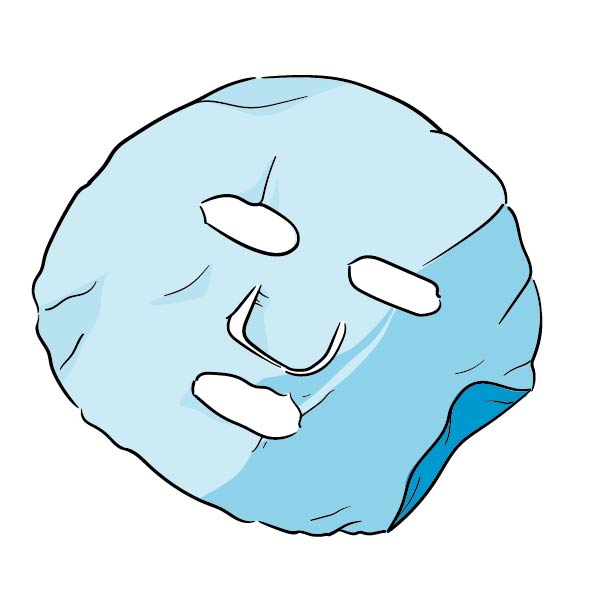FEATUREs:
- Single-use
- Good for normal, oily, combination, dry, and sensitive skin
- A solution for dryness, dullness, and blemishes
Recently, I went on holiday with friends. We had all separately been having a bad time, and we decided to attempt having a bad time together. Each of us had just turned thirty, or was about to turn thirty, and the mood was one of slow panic. On a quiet night, Jackie, who had arrived from Hong Kong, took out from her luggage several boxes of sheet masks. They were of every possible type—clay, charcoal, rubber—with every possible benefit: plumping, purifying, detoxifying. We sat in the Airbnb and diligently applied them; I chose a hydrating one. We took group selfies in which we looked simultaneously like the villains and the victims of a slasher movie. I think we believed that when we removed the masks, all the blemishes of the last year would cleanly peel away.
I use sheet masks the most when I’m at my lowest. I believe everything in my life can improve if my skin is fully hydrated. I had a one-a-day habit in the run-up to being fired, which continued after being fired. I’ve used them after debilitating hangovers, after being dumped, and, in a burst of hopefulness, just before being dumped. As a teenager, I had acne. I’d go weeks without looking in a mirror. I didn’t want products, or advice on what my skin type was; I didn’t want to acknowledge my own face. This meant I didn’t develop vanity until later in life. (Don’t worry; I’ve made up for it.)
Sheet masks, we are told, can be easily incorporated into a woman’s daily routine. This, like many things said about products sold to women, is a lie. When you are wearing a sopping weave of bleached wool pulp fibers over your face, your options are to recline on a couch or on a bed, and breathe shallowly. Your features will not align with the cutout orifices of the mask, so you must tamp the sheet down along the sides of the nose, in the pocket between the lower lip and chin, under the eyes. If you like, while you wait the twenty-five minutes or so until maximum hydration, you can stare into the mirror and think about Eyes without a Face, Georges Franju’s 1960 horror film about the dangers of idealized female beauty.
Sheet masks originated in South Korea and Japan, two countries where women employ a strict ten-step nighttime routine. Their rise in popularity coincided with a certain genre of beauty tutorial videos known as “Go to Bed with Me.” I watch at least one of these videos a week. In them, a young woman guides the viewer through the steps of her nightly beauty ritual. She speaks in soft baby talk. She stands in a cavernous bathroom, wearing a white terry cloth dressing gown, and applies various cleansers, ointments, and serums. I hang on every word. Inevitably, one of the steps will be a sheet mask: the woman will put it on with a small self-deprecating laugh to acknowledge the goofiness of her appearance—which isn’t goofy at all but, even under the sticky white sheet, alert and controlled—then the cameras will cut away to show the passage of time and the woman will reappear, her face conspicuously improved.
These women are so generous with their faces—pointing out their flaws under harsh lighting, decrying air pollution—it’s as if they don’t fully own them: they are renting them to us for the duration of the video. The woman washing her face alone in her bathroom is now a spectacle, a private act turned into a performance. These videos satisfy my desire for self-improvement and also my voyeuristic side.
The sheet mask’s appeal is not only the exquisite cleanness promised by every new package, but also its relative affordability. You can’t acquire these women’s dermatologists or dieticians, their poise or their taste—but you can buy a slick, wet piece of paper from Sephora for six dollars. The videos promise that life’s unpredictability can be managed by the consistency of one’s before-bed skin-care routine. It’s not the results that are important but the process.
Perhaps I’m not giving these women enough credit. Perhaps they are like me, and their desire for better skin is in direct competition with their desire to kick it all in. Lately, though, it’s hard not to see the whole enterprise as sinister, wasteful, and cruel: another isolating and arduous feminine task dressed up in cute clothing. A single-use textile seamlessly moving from your face to the trash bin, contributing to the already catastrophic destruction of our planet. Sheet masks won’t make you immortal, but they themselves often are: it takes hundreds of years for some of them to fully decompose.
Then again, don’t let me put you off. Buy a sheet mask. Don’t look too closely at the ingredients—it’s mostly water. Tear open the smooth plastic at the notch and slide out the mask. Its weight will be pleasing and its temperature cool. Unfold the sheet, being careful not to let any of the serum drip. Detach the nose cover from the upper lip and drape the paper over your face. Smooth it down, every surface covered. Wait fifteen to twenty-five minutes. Don’t look in the mirror. Breathe shallowly. Don’t open your mouth too wide. Then peel off the mask, discard it, and discover your new self: your body desirable, your personality improved, your vocabulary expanded, your conversation sparkling, your ideas clarified, your jokes on point, your regrets forgotten, your mistakes forgiven, your kindness immense, your skin luminous, smooth, and perfect.





